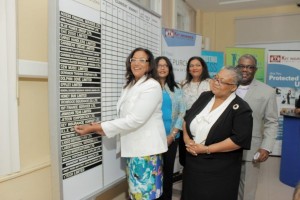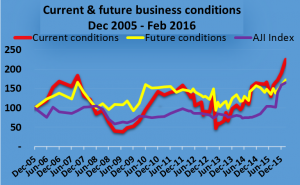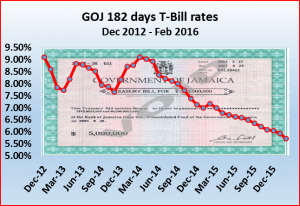
Natalia Gobin-Gunter Chairman and Deputy Managing director inserting name strip to indicate listing of Key Insurance on the junior market.
The survey findings of carried out amongst Jamaica’s business executives, show wild swings in their views on current conditions since the start of the data in 2005, while the index of future business conditions was far more predictive of actual business developments. The attached chart shows this up quite clearly. Other findings of the survey also points out that the top management of the various companies were was off the mark when it came to inflation, interest rates and the rate of exchange of the local dollar. One of the clearest measures to test what the executives say and do, is a comparison of the sentiments on business conditions and the performance of the stock market.
When it came time for the business community to put their money where their mouth is, it turned out to be vastly different from what they were saying in the Business Condition Survey. One measure of the business community’s bet on the future, is shown in the attached graph. The graph shows future expectations are is much more aligned with future business conditions than with current ones.
 What the business sector did, reflected itself in a much smoother monthly movement than what they said about the future. When it comes to money, the stock market reflects what people are doing with their money as opposed to what they say. The chart shows the movement in the all Jamaica Composite Index, plotted against the two business surveys published by the country’s central bank.
What the business sector did, reflected itself in a much smoother monthly movement than what they said about the future. When it comes to money, the stock market reflects what people are doing with their money as opposed to what they say. The chart shows the movement in the all Jamaica Composite Index, plotted against the two business surveys published by the country’s central bank.The movement of the stock market seems a better predictor of future expectations, than the surveys, as shown by the smoother movement of the stock market compared with the sentiments data. What is also true, is that the future expectations and the stock market movements are fairly closely aligned with each other.
 Prices as measured by the consumer price index fell 0.1 percent in March 2016 according to a report released by the Statistical Institute of Jamaica. For the calendar year-to-date there was a decline in inflation of 1.3 percent.
Prices as measured by the consumer price index fell 0.1 percent in March 2016 according to a report released by the Statistical Institute of Jamaica. For the calendar year-to-date there was a decline in inflation of 1.3 percent. Jamaica’s creditworthiness is improving, Scotiabank’s economic units stated in the economic Executive Briefing on Jamaica. Fitch recently upgraded the country’s sovereign credit rating to “B” and assigned it a “stable” outlook Scotiabank Economic report says.
Jamaica’s creditworthiness is improving, Scotiabank’s economic units stated in the economic Executive Briefing on Jamaica. Fitch recently upgraded the country’s sovereign credit rating to “B” and assigned it a “stable” outlook Scotiabank Economic report says.  After losing nearly 30% of its value since 2012, the Jamaican dollar (JMD) is expected to maintain a defensive tone against the US dollar (USD).
After losing nearly 30% of its value since 2012, the Jamaican dollar (JMD) is expected to maintain a defensive tone against the US dollar (USD). 
 The capital budgeted expenditure that is usually underspent in past years has been fully used up to the end of February but the government incurred less on debt servicing with lower interest cost of $3 billion for the elven months period.
The capital budgeted expenditure that is usually underspent in past years has been fully used up to the end of February but the government incurred less on debt servicing with lower interest cost of $3 billion for the elven months period. Jamaica garnered just 3.2 percent or US$69 million in
Jamaica garnered just 3.2 percent or US$69 million in  Jamaica continued to enjoy positive inflows of foreign exchange from overseas in the area of remittances. For the first eleven months of 2015, total
Jamaica continued to enjoy positive inflows of foreign exchange from overseas in the area of remittances. For the first eleven months of 2015, total  The 182 days instrument fell by 21 basis points to 5.73 percent but the 91 days instrument climbed back above the 6 percent mark to end at 6 percent, up from 5.94 percent in January.
The 182 days instrument fell by 21 basis points to 5.73 percent but the 91 days instrument climbed back above the 6 percent mark to end at 6 percent, up from 5.94 percent in January.







